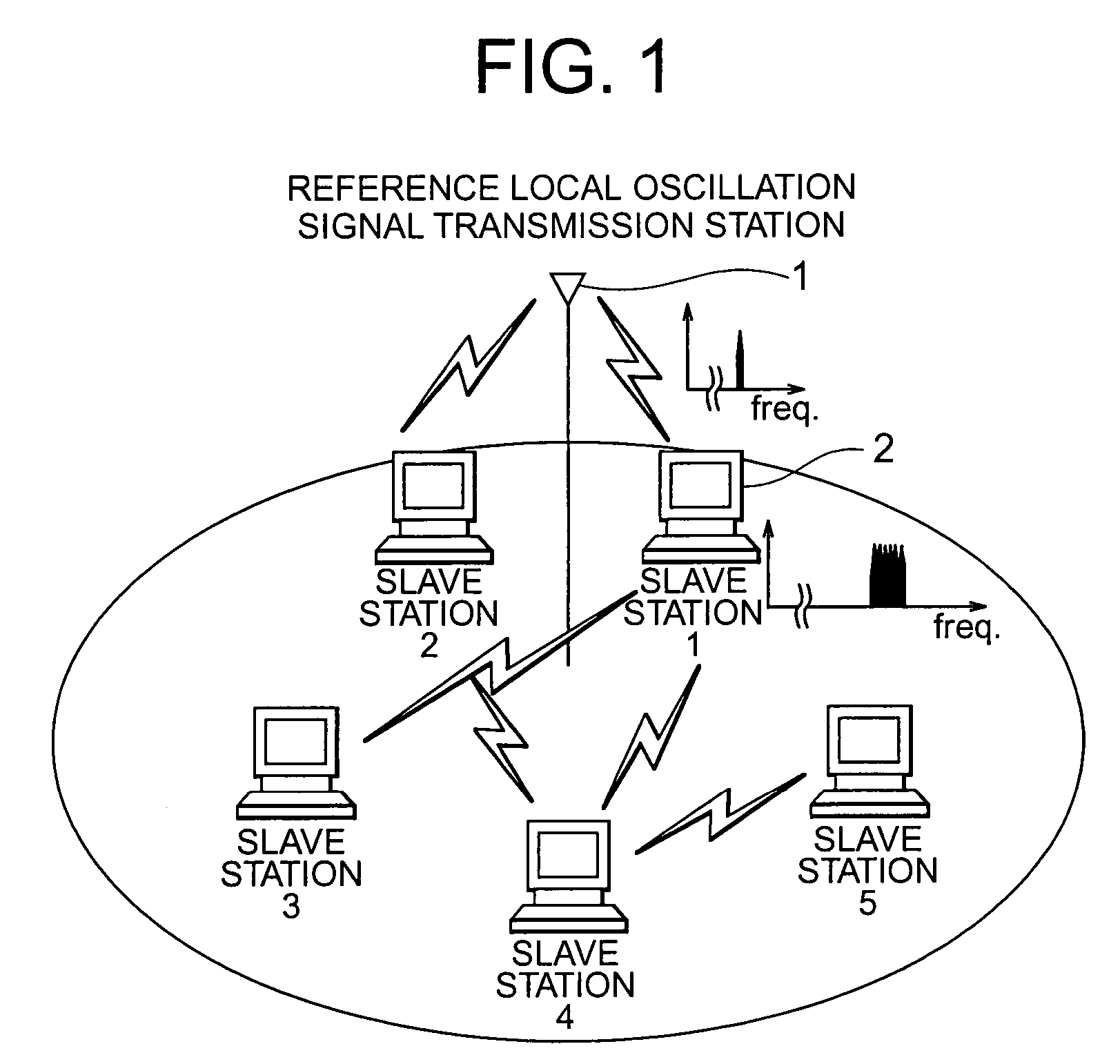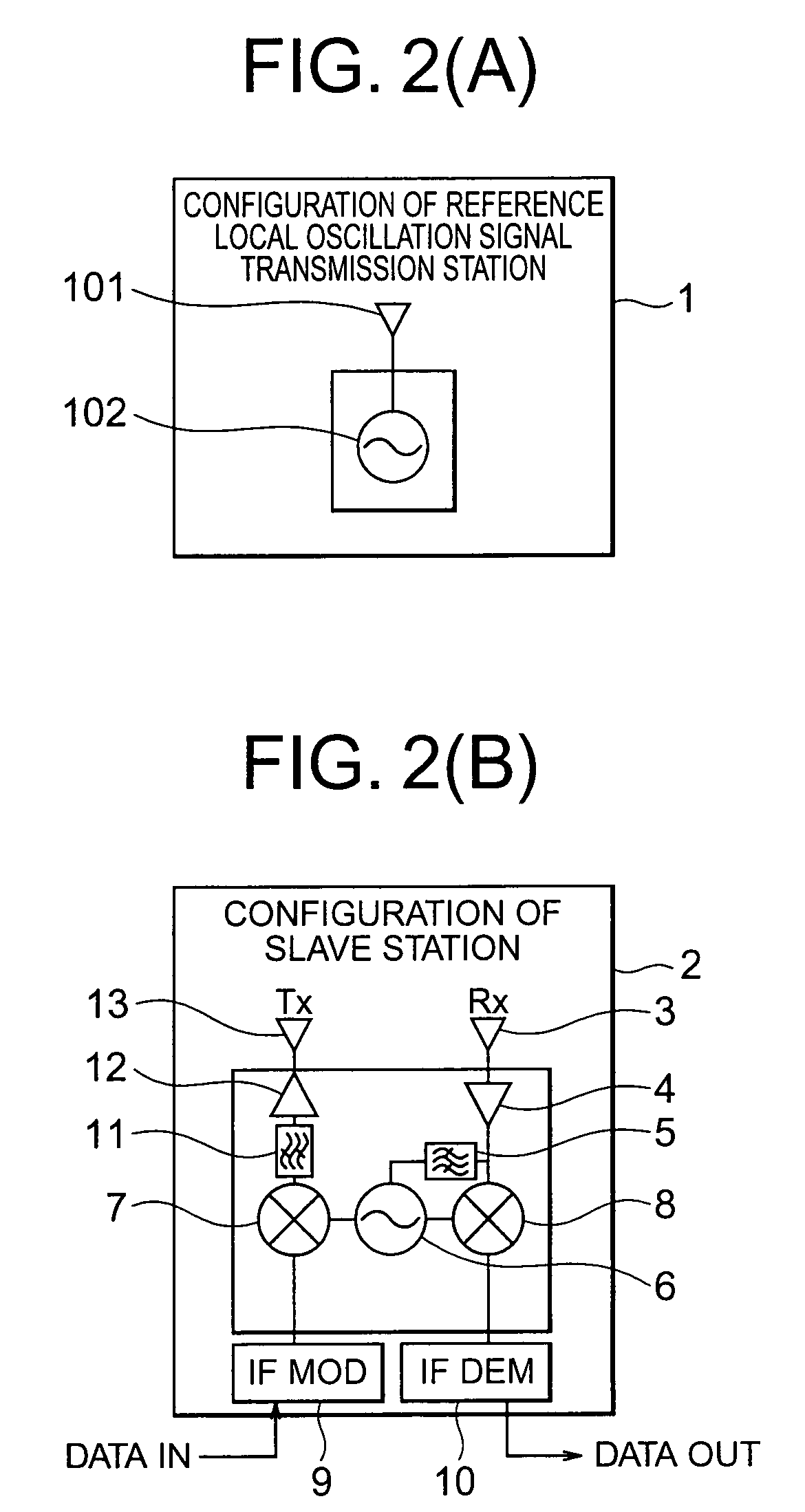Radio communication method and system for performing communication among a plurality of radio communication terminals
a radio communication terminal and communication method technology, applied in the direction of synchronisation arrangement, oscillator generator, wireless commuication services, etc., can solve problems such as difficulties in configuring a radio communication system, and achieve the effects of large phase noise, high-quality signal transmission, and large phase nois
- Summary
- Abstract
- Description
- Claims
- Application Information
AI Technical Summary
Benefits of technology
Problems solved by technology
Method used
Image
Examples
first embodiment
[0017]FIG. 1 shows the configuration of a radio communication system according to a first embodiment of the present invention, along with transmission signal spectrum of each station. FIGS. 2(A) and 2(B) respectively show the specific configurations of a reference local oscillation signal transmission station and a slave station of the radio communication system of the first embodiment. A reference local oscillation signal transmission station 1 radiates a reference local oscillation signal generated at a reference local oscillator 102 to a service zone via a transmission antenna 101. Each radio slave station terminal 2 (slave station No. 1, slave station No. 2, slave station No. 3, etc.) receives the reference local oscillation signal via an antenna 3. The received reference local oscillation signal is amplified by means of an amplifier 4, and a portion of the amplified reference local oscillation signal is passed through a band-pass filter 5 for removal of unnecessary waves and is...
second embodiment
[0019]FIG. 3 shows the configuration of a radio communication system according to the second embodiment of the present invention, along with the transmission signal spectrum of each station. FIGS. 4(A) and 4(B) respectively show the specific configurations of a base station and a slave station of the radio communication system of the second embodiment. In a base station 14, an IF band modulated signal received from an IF band modulated signal generator 15 is fed to a mixer 17, to which a signal from a local oscillator 16 is supplied. Thus, the IF band modulated signal is converted to a signal in the radio frequency band. The thus-obtained radio signal is passed through a band-pass filter 18 so as to remove unnecessary wave components therefrom. A portion of a local oscillation signal, which serves as a reference local oscillation signal within the network, is added to the radio signal. A resultant radio signal is amplified by means of an amplifier 19 and is then transmitted from an ...
third embodiment
[0021]FIG. 5 shows the configuration of a radio communication system according to a third embodiment of the present invention, along with the transmission signal spectrum of each station. FIGS. 6(A) and 6(B) respectively show the specific configurations of a slave station (master mode) and a slave station (slave mode) of the radio communication system of the third embodiment. The present radio communication system consists of a plurality of slave station terminals (slave station No. 1, slave station No. 2, slave station No. 3, etc.). However, each of the terminals is designed in such a manner that it can selectively assume either of two states; i.e., a master mode and a slave mode, and that, in a single network, only one slave station can operate in the master mode, that slave station being determined by a protocol of an upper layer with resect to the physical layer. In a slave station 37 having entered the master mode, a switch 38 is switched to a master mode side by means of a swi...
PUM
 Login to View More
Login to View More Abstract
Description
Claims
Application Information
 Login to View More
Login to View More - R&D
- Intellectual Property
- Life Sciences
- Materials
- Tech Scout
- Unparalleled Data Quality
- Higher Quality Content
- 60% Fewer Hallucinations
Browse by: Latest US Patents, China's latest patents, Technical Efficacy Thesaurus, Application Domain, Technology Topic, Popular Technical Reports.
© 2025 PatSnap. All rights reserved.Legal|Privacy policy|Modern Slavery Act Transparency Statement|Sitemap|About US| Contact US: help@patsnap.com



